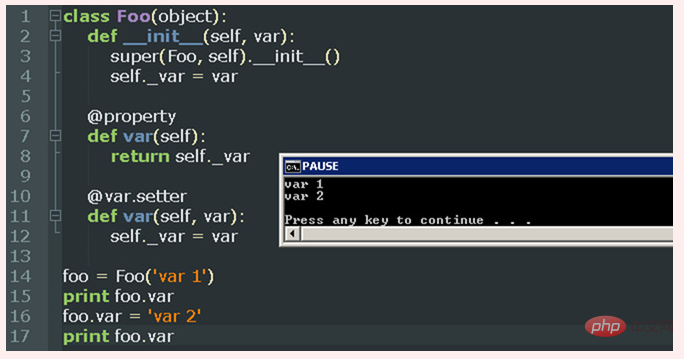Detailed explanation of python decorators

Detailed analysis of python decorator
Detailed analysis of python decorator
What Is it a decorator?
Recommended learning: Python video tutorial
Python decorators (fuctional decorators) are functions used to expand the functionality of the original function. The purpose is to When changing the original function name (or class name), add new functions to the function.
The special thing about this function is that its return value is also a function. This function is a function with the "original" function embedded in it.
Generally speaking, if we want to expand the original function code, the most direct way is to invade the code and modify it, for example:
import time
def f():
print("hello")
time.sleep(1)
print("world")
This is our most original function, and then we try to record the total execution time of this function, then The simplest way is to change the original code:
import time
def f():
start_time = time.time()
print("hello")
time.sleep(1)
print("world")
end_time = time.time()
execution_time = (end_time - start_time)*1000
print("time is %d ms" %execution_time)
But in actual work, sometimes the core code cannot be changed directly, so without changing the original code, we You can define another function. (But the function needs to be executed again to take effect)
import time
def deco(func):
start_time = time.time()
f()
end_time = time.time()
execution_time = (end_time - start_time)*1000
print("time is %d ms" %execution_time)
def f():
print("hello")
time.sleep(1)
print("world")
if __name__ == '__main__':
deco(f)
print("f.__name__ is",f.__name__)
print()
Here we define a function deco, whose parameter is a function, and then embed the timing function into this function . But if you want to expand the functions of these tens of millions of functions,
means executing the deco() function ten million times, so this is not ideal! Next, we can try to use decorators to achieve it. First Take a look at the most original appearance of the decorator.
import time
def deco(f):
def wrapper():
start_time = time.time()
f()
end_time = time.time()
execution_time = (end_time - start_time)*1000
print("time is %d ms" %execution_time )
return wrapper
@deco
def f():
print("hello")
time.sleep(1)
print("world")
if __name__ == '__main__':
f()
The deco function here is the most original decorator. Its parameter is a function, and the return value is also a function.
The function f() as a parameter is executed inside the return function wrapper(). Then add @deco in front of the function f(),
f() function is equivalent to being injected With the timing function, now as long as f() is called, it has been transformed into a "new function with more functions",
(no need to repeat the original function).
Extension 1: Decorator with fixed parameters
import time
def deco(f):
def wrapper(a,b):
start_time = time.time()
f(a,b)
end_time = time.time()
execution_time = (end_time - start_time)*1000
print("time is %d ms" % execution_time)
return wrapper
@deco
def f(a,b):
print("be on")
time.sleep(1)
print("result is %d" %(a+b))
if __name__ == '__main__':
f(3,4)Extension 2: Decorator without fixed parameters
import time
def deco(f):
def wrapper(*args, **kwargs):
start_time = time.time()
f(*args, **kwargs)
end_time = time.time()
execution_time_ = (end_time - start_time)*1000
print("time is %d ms" %execution_time)
return wrapper
@deco
def f(a,b):
print("be on")
time.sleep(1)
print("result is %d" %(a+b))
@deco
def f2(a,b,c):
print("be on")
time.sleep(1)
print("result is %d" %(a+b+c))
if __name__ == '__main__':
f2(3,4,5)
f(3,4)
Extension 3: Use multiple decorators to decorate a function
import time
def deco01(f):
def wrapper(*args, **kwargs):
print("this is deco01")
start_time = time.time()
f(*args, **kwargs)
end_time = time.time()
execution_time = (end_time - start_time)*1000
print("time is %d ms" % execution_time)
print("deco01 end here")
return wrapper
def deco02(f):
def wrapper(*args, **kwargs):
print("this is deco02")
f(*args, **kwargs)
print("deco02 end here")
return wrapper
@deco01
@deco02
def f(a,b):
print("be on")
time.sleep(1)
print("result is %d" %(a+b))
if __name__ == '__main__':
f(3,4)''' this is deco01 this is deco02 hello,here is a func for add : result is 7 deco02 end here time is 1003 ms deco01 end here '''
Decorator calling order
Decorators can be used superimposed, so what is the order of the code after using the decorator?
For the "@" syntax in Python Sugar, the order in which the decorators are called is the reverse of the order declared using the @ syntax sugar.
In this example, "f(3, 4) = deco01(deco02(f(3, 4)))".
Python built-in decorators
There are three built-in decorators in Python, all related to classes: staticmethod, classmethod and property .
staticmethod is a class static method. Its difference from the member method is that it has no self parameter and can be called without instantiating the class.
The difference between classmethod and member method is that The first parameter received is not self (a pointer to a class instance), but cls (the specific type of the current class)
property means property, indicating information that can be directly accessed through a class instance
I won’t introduce staticmethod and classmethod here. Let’s take a look at property through an example.

Note that for Python new-style classes, if the member function decorated by the "@var.setter" decorator above is removed, Foo. The var attribute is a read-only attribute, and an exception will be thrown when assigning a value using "foo.var = 'var 2′". However, for Python classic class, the declared attributes are not read-only, so even if the "@var.setter" decorator is removed, no error will be reported.
Summary
This article introduces some uses of Python decorators. The code of the decorator is relatively easy to understand. It is easy to understand as long as you practice it through some examples.
The above is the detailed content of Detailed explanation of python decorators. For more information, please follow other related articles on the PHP Chinese website!

Hot AI Tools

Undresser.AI Undress
AI-powered app for creating realistic nude photos

AI Clothes Remover
Online AI tool for removing clothes from photos.

Undress AI Tool
Undress images for free

Clothoff.io
AI clothes remover

Video Face Swap
Swap faces in any video effortlessly with our completely free AI face swap tool!

Hot Article

Hot Tools

Notepad++7.3.1
Easy-to-use and free code editor

SublimeText3 Chinese version
Chinese version, very easy to use

Zend Studio 13.0.1
Powerful PHP integrated development environment

Dreamweaver CS6
Visual web development tools

SublimeText3 Mac version
God-level code editing software (SublimeText3)

Hot Topics
 PHP and Python: Different Paradigms Explained
Apr 18, 2025 am 12:26 AM
PHP and Python: Different Paradigms Explained
Apr 18, 2025 am 12:26 AM
PHP is mainly procedural programming, but also supports object-oriented programming (OOP); Python supports a variety of paradigms, including OOP, functional and procedural programming. PHP is suitable for web development, and Python is suitable for a variety of applications such as data analysis and machine learning.
 Choosing Between PHP and Python: A Guide
Apr 18, 2025 am 12:24 AM
Choosing Between PHP and Python: A Guide
Apr 18, 2025 am 12:24 AM
PHP is suitable for web development and rapid prototyping, and Python is suitable for data science and machine learning. 1.PHP is used for dynamic web development, with simple syntax and suitable for rapid development. 2. Python has concise syntax, is suitable for multiple fields, and has a strong library ecosystem.
 Python vs. JavaScript: The Learning Curve and Ease of Use
Apr 16, 2025 am 12:12 AM
Python vs. JavaScript: The Learning Curve and Ease of Use
Apr 16, 2025 am 12:12 AM
Python is more suitable for beginners, with a smooth learning curve and concise syntax; JavaScript is suitable for front-end development, with a steep learning curve and flexible syntax. 1. Python syntax is intuitive and suitable for data science and back-end development. 2. JavaScript is flexible and widely used in front-end and server-side programming.
 PHP and Python: A Deep Dive into Their History
Apr 18, 2025 am 12:25 AM
PHP and Python: A Deep Dive into Their History
Apr 18, 2025 am 12:25 AM
PHP originated in 1994 and was developed by RasmusLerdorf. It was originally used to track website visitors and gradually evolved into a server-side scripting language and was widely used in web development. Python was developed by Guidovan Rossum in the late 1980s and was first released in 1991. It emphasizes code readability and simplicity, and is suitable for scientific computing, data analysis and other fields.
 Can vs code run in Windows 8
Apr 15, 2025 pm 07:24 PM
Can vs code run in Windows 8
Apr 15, 2025 pm 07:24 PM
VS Code can run on Windows 8, but the experience may not be great. First make sure the system has been updated to the latest patch, then download the VS Code installation package that matches the system architecture and install it as prompted. After installation, be aware that some extensions may be incompatible with Windows 8 and need to look for alternative extensions or use newer Windows systems in a virtual machine. Install the necessary extensions to check whether they work properly. Although VS Code is feasible on Windows 8, it is recommended to upgrade to a newer Windows system for a better development experience and security.
 Can visual studio code be used in python
Apr 15, 2025 pm 08:18 PM
Can visual studio code be used in python
Apr 15, 2025 pm 08:18 PM
VS Code can be used to write Python and provides many features that make it an ideal tool for developing Python applications. It allows users to: install Python extensions to get functions such as code completion, syntax highlighting, and debugging. Use the debugger to track code step by step, find and fix errors. Integrate Git for version control. Use code formatting tools to maintain code consistency. Use the Linting tool to spot potential problems ahead of time.
 How to run programs in terminal vscode
Apr 15, 2025 pm 06:42 PM
How to run programs in terminal vscode
Apr 15, 2025 pm 06:42 PM
In VS Code, you can run the program in the terminal through the following steps: Prepare the code and open the integrated terminal to ensure that the code directory is consistent with the terminal working directory. Select the run command according to the programming language (such as Python's python your_file_name.py) to check whether it runs successfully and resolve errors. Use the debugger to improve debugging efficiency.
 Is the vscode extension malicious?
Apr 15, 2025 pm 07:57 PM
Is the vscode extension malicious?
Apr 15, 2025 pm 07:57 PM
VS Code extensions pose malicious risks, such as hiding malicious code, exploiting vulnerabilities, and masturbating as legitimate extensions. Methods to identify malicious extensions include: checking publishers, reading comments, checking code, and installing with caution. Security measures also include: security awareness, good habits, regular updates and antivirus software.






